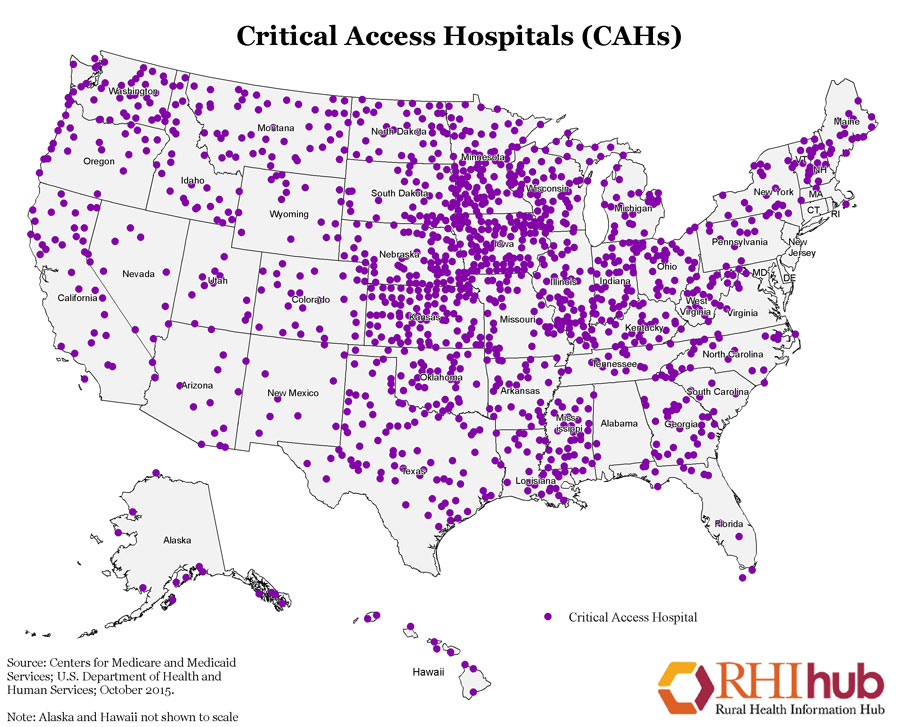Rural Health and the Healthcare Connect Fund
TD SYNNEX has recognized extraordinary success using the USAC eRate program to help educational entities secure funding to build out bandwidth into rural and underserved communities. Similarly, USAC administers the Healthcare Connect Fund that allows for rural-health entities to access funds to build out bandwidth and infrastructure. USAC administers a budget of $400M annually for Rural Healthcare Entities available for telecommunications and broadband funding via the Healthcare Connect Fund Funded though FCC fees.
Below are some of the hospitals and health centers who may qualify for the Healthcare Connect Fund program. For additional information on how TD SYNNEX GOVSolv can assist with your healthcare business, join our GOVSolv Program here.
Critical Access Hospitals
A Critical Access Hospital (CAH) has been certified under a set of Medicare Conditions of Participation (CoP), which are structured differently than the acute-care hospital CoP. Some of the requirements for CAH certification include having no more than 25 inpatient beds; maintaining an annual average length of stay of no more than 96 hours for acute inpatient care; offering 24-hour, 7-day-a-week emergency care; and being located in a rural area, at least a 35-mile drive away from any other hospital or CAH (fewer in some circumstances). The limited size and short stays allowed to CAHs encourage a focus on providing care for common conditions and outpatient care, while referring other conditions to larger hospitals. Certification allows CAHs to receive cost-based reimbursement from Medicare, instead of standard fixed reimbursement rates. This reimbursement has been shown to enhance the financial performance of small rural hospitals that were losing money prior to CAH conversion and thus reduce hospital closures.
Critical Access Hospitals have the same needs related to security, mobility, and patient engagement that large hospitals and networks have. Due to the mandate requiring that they refer out specialist cases, they have needs for increasing telemedicine services.
There are 1,333 CAH designates as of Sept. 1, 2015.

Community Health Centers
Community health centers offer essential primary- and preventive-care services to populations with limited access to health care. Available services can range from basic doctor’s visits, immunizations, health screenings, laboratory and radiology, pharmacy, dental, and mental-health services. Typically, services are provided on a sliding scale, based on an individual’s ability to pay.
Health centers frequently extend beyond the center’s walls to better-reach underserved populations. Community health centers care for 16 million people at more than 6,000 locations across the nation. Of those served at health centers, 71 percent are below 100 percent of the federal poverty guidelines and 92 percent are below 200 percent. In addition, 40 percent are uninsured while 35 percent are enrolled in Medicaid or SCHIP and sixty percent are Hispanic, African-American, or Native American, while 35 percent are under the age of 20.
Funding for health centers comes from a variety of public and private sources. According to the National Association of Community Health Centers, health centers receive half of their funds from state and local sources, such as Medicaid, state and local funds, and to a small extent, the children’s health insurance program. The remainder comes from federal grants, private insurance, Medicare, and patients themselves.
While the term “community health center” is often used to describe a wide variety of providers, it officially covers three categories:
- Federally Qualified Health Centers are authorized public or private non-profit organizations that receive federal grants in order to serve migrant workers, homeless populations, residents of public housing and other underserved communities
- Federally Qualified Health Center lookalikes meet the Centers for Medicare and Medicaid Services (CMS) definition of a health center, but do not receive grant funding through Health Center Program (Section 330 of the Public Health Service Act). Many of these are newly established and in the process of qualifying for grant funding
- Finally, some facilities operated by tribal organizations also qualify as health centers
For additional information on how TD SYNNEX GOVSolv can assist with your healthcare business, join our GOVSolv Community here.
